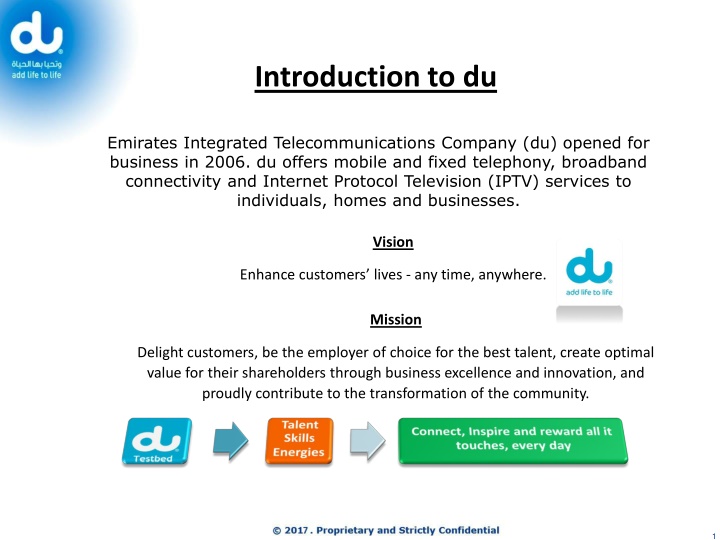Introduction to du
Offering mobile and fixed telephony, broadband connectivity, and IPTV services, du supports business excellence and innovation. With the depletion of IPv4 addresses, transitioning to IPv6 becomes essential for expanding networks and accommodating new trends like IoT and Smart Cities.
Download Presentation

Please find below an Image/Link to download the presentation.
The content on the website is provided AS IS for your information and personal use only. It may not be sold, licensed, or shared on other websites without obtaining consent from the author.If you encounter any issues during the download, it is possible that the publisher has removed the file from their server.
You are allowed to download the files provided on this website for personal or commercial use, subject to the condition that they are used lawfully. All files are the property of their respective owners.
The content on the website is provided AS IS for your information and personal use only. It may not be sold, licensed, or shared on other websites without obtaining consent from the author.
E N D
Presentation Transcript
Introduction to du Emirates Integrated Telecommunications Company (du) opened for business in 2006. du offers mobile and fixed telephony, broadband connectivity and Internet Protocol Television (IPTV) services to individuals, homes and businesses. Vision Enhance customers lives - any time, anywhere. Mission Delight customers, be the employer of choice for the best talent, create optimal value for their shareholders through business excellence and innovation, and proudly contribute to the transformation of the community. 1
WHY IPv6 ? 1.A : IPv4 public IP s depletion As our network and services expand we will need more public IPv4 IP s & the IPv4 Pool available with IANA is nearly depleted resulting in the IPv4 public IP s being costly and unavailable. Public IPv4 Utilization Du Public IP Range 5.X.X.X/17 5.X.X.X/15 80.X.X.X/16 87.X.X.X/15 91.X.X.X/14 94.X.X.X/13 213.X.X.X/19 Jan-17 89% 57% 63% 38% 73% 68% 91% 91% 89% 100% 73% 90% 68% 63% 80% 57% 70% 60% 38% 50% 40% 30% 20% 10% 0% Total Utilization 68% 2
1.B IPv4 private IPs depletion Private IPv4 IP s segment available is also limited and we will be facing difficulties in expanding our internal networks if we keep relying on IPv4 IPs on the long run. Private IPv4 Utilization 70% 70% 60% 50% Du Private IP Range 172.X.X.X/12 10.X.X.X/8 3x 192.X.X.X/16 Jan-17 12% 70% 0% 40% 30% 12% 20% 0% 10% 0% Total Utilization 64% X.16.0.0/12 X.0.0.0/8 X.168.0.0/16 3
2) Business new trends and the new concepts: Like IOT (Internet of Things), IOE (Internet of Everything) , M2M (Machine to Machine) and Smart Cities that are expected to connect huge number of devices to the internet and will need huge number of IPs that cannot be accommodated by current capacity of IPv4 IPs. 4
3) Ability to provide wider ranges of useable IPs to our enterprise customers which means potential for new business opportunities. 4) To enhance security the NATTING proportion b/w the Private to Public IP s in the network needs t be reduced. This requires huge numbers of Public IP s to be purchased which were not available with RIPE & acquiring the same from Open market would incur huge costs. This will be resolved with the induction of the IPv6 in the Network as this will eliminate the issue of IP scarcity. 5
IPv6 Transition Approach Save on IPv4 Address Consumption Post Offer IPv4 /IPv6 Dual Stack Dual Stack strategy Private & Public IPv4 optimization Enabling IPv6 in Core, Edge and IGW DS-Lite Implement centralized BNG model for all fixed residential Use 6vPE / 6PE in the IP Core layer. NAT-64 Enable IPv6 DS on the BNG for fixed residential Reclaim poorly-used IPv4 address blocks DNS-64 Enable IPv6 DS on the Mobile GWs for mobile users Continue Using Private IPv4 for mobile data with NAT Enable IPv6 DS for enterprise customer on the Service edge Migrate the Mobile IPv4 addresses allocation to MPLS/VPN Xlat-464 6
WHERE WE ARE TODAY Network Layers Supporting IPv6 Service Network Layers currently under testing for IPv6 Service 7
Success Stories 1.Dual Stack WiFi POC All the Offices in Du were equipped with additional WiFi AP s providing dual stack (IPV6/IPV4) access to the internet. The objective of this exercise was to test end user experience with dual stack browsing while using different terminals. It will also serve as a Launching pad for the full scale WiFi Deployment planned this year. 9
2.Dual Stack based Mobile Data Browsing FUT One of the Major Service impacted by IPv4 exhaustion is the mobile Data Browsing as for the PDP APN IP Pools are required. Du s strategy was that Services impacted by IPv4 exhaustion are to adopt IPv6 Transit Plan first. In line with the strategy we are enabling the PDP APN Pool & the Gi Path to handle Dual Stack. 11
Testing updates from Mobile Terminal Vendors Test Result Mobile Test Result WiFi S No# Vendor Comments/Updates 1 Apple Passed Passed Testing is successful for both DHCPv6 and SLAAC. As other Android handsets, it supports SLAAC only, can be pushed to customers once we give vendor Go ahead. 2 Samsung Passed Passed As other Android handsets, it supports SLAAC only. 3 HTC Passed Passed 4 LG Passed Passed As other Android handsets, it supports SLAAC only BB10 support IPV6 only with WiFi interface but not with Mobile interface. Supports dual stack from Ascend Mate onwards. Should act as other Android handsets 6 Blackberry Not Applicable Passed 7 Huawei Not Tested Not Tested 8 Microsoft Not Tested Passed Works fine with DHCPV6 and SLAAC. 9 Sony Not tested Not Tested Should act as other Android handsets 12
Testing updates from Fixed CPE Vendors Test Result IP TV Test Result WiFi S No# Vendor Comments/Updates 1 Nokia Passed Passed 2 Huawei Passed Passed 13
Lessons Learned IPV6 was not working initially on the DNS/DHCP server. After investigation we figured out that IPv6 should be manually enabled on DNS/DHCP Server. As per the support documentation that should be enabled by default. Android Phones were not working with DHCPv6, we configured both SLAAC and DHCPv6, In case end device doesn t support SLAAC address it will request for DHCPv6 address. VSS devices should be running on the latest IOS versions to support the IPv6 Filtering. The Prepaid / Postpaid bundles triggering & DPI required extensive development & testing on the UGW side. IT Mediation Team & the Down stream teams [Data Warehouse] required development & testing to ingest the modified format of the CDR s. The Provisioning systems [BSCS / HPSA ] required package upgrades to support the provisioning. 14








